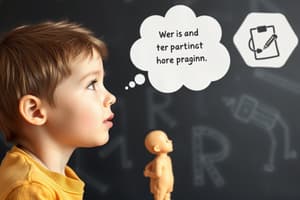Podcast
Questions and Answers
Which of the following is not a cognitive strategy for emotional regulation?
Which of the following is not a cognitive strategy for emotional regulation?
- Suppression (correct)
- Cognitive reappraisal
- Rumination
- Distraction
Emotional maturity includes the ability to handle change with flexibility.
Emotional maturity includes the ability to handle change with flexibility.
True (A)
What is the purpose of emotional regulation?
What is the purpose of emotional regulation?
To influence one's emotions.
_____ is the attempt to deny or mask one's emotional state.
_____ is the attempt to deny or mask one's emotional state.
Match the following strategies with their descriptions:
Match the following strategies with their descriptions:
What role do emotions play in decision-making?
What role do emotions play in decision-making?
Emotions are purely mental portrayals and do not involve biological responses.
Emotions are purely mental portrayals and do not involve biological responses.
What are emotions primarily responsible for in terms of survival?
What are emotions primarily responsible for in terms of survival?
Emotions create biochemical reactions in the body that can lead to changes in one’s __________ state.
Emotions create biochemical reactions in the body that can lead to changes in one’s __________ state.
Match the following pairs of emotions and their corresponding feelings:
Match the following pairs of emotions and their corresponding feelings:
Which of the following describes the difference between emotions and feelings?
Which of the following describes the difference between emotions and feelings?
Feelings are always a direct reflection of the original emotion felt.
Feelings are always a direct reflection of the original emotion felt.
How can emotional intelligence be applied to daily life?
How can emotional intelligence be applied to daily life?
Which of the following is NOT a branch of Mayer, Salovey, and Caruso's model of emotional intelligence?
Which of the following is NOT a branch of Mayer, Salovey, and Caruso's model of emotional intelligence?
Self-awareness is one of the clusters proposed by Goleman in his model of emotional intelligence.
Self-awareness is one of the clusters proposed by Goleman in his model of emotional intelligence.
What is defined as the ability to understand and manage one's own emotions and those of others?
What is defined as the ability to understand and manage one's own emotions and those of others?
Goleman's model includes self-awareness, self-management, social awareness, and _____ management.
Goleman's model includes self-awareness, self-management, social awareness, and _____ management.
Match the following clusters of Goleman's emotional intelligence model with their components:
Match the following clusters of Goleman's emotional intelligence model with their components:
Which of the following is considered an aspect of interpersonal emotional intelligence?
Which of the following is considered an aspect of interpersonal emotional intelligence?
Bar-On's model of emotional intelligence has three composites.
Bar-On's model of emotional intelligence has three composites.
Who proposed the model that includes emotional perception, emotional facilitation, emotional understanding, and reflective emotional regulation?
Who proposed the model that includes emotional perception, emotional facilitation, emotional understanding, and reflective emotional regulation?
Flashcards
Emotions
Emotions
Lower-level brain responses causing biochemical reactions that change the physical state.
Emotional Intelligence
Emotional Intelligence
Understanding and managing one's own emotions and the emotions of others.
Emotions vs. Feelings
Emotions vs. Feelings
Emotions are physical responses; feelings are mental interpretations of those responses, based on personal experiences.
Emotion
Emotion
Signup and view all the flashcards
Feeling
Feeling
Signup and view all the flashcards
Survival Function (Emotions)
Survival Function (Emotions)
Signup and view all the flashcards
Factors influencing emotions
Factors influencing emotions
Signup and view all the flashcards
Emotional Self
Emotional Self
Signup and view all the flashcards
Emotional Intelligence Definition
Emotional Intelligence Definition
Signup and view all the flashcards
Emotional Intelligence Models
Emotional Intelligence Models
Signup and view all the flashcards
Self-awareness (EI)
Self-awareness (EI)
Signup and view all the flashcards
Self-management (EI)
Self-management (EI)
Signup and view all the flashcards
Social Awareness (EI)
Social Awareness (EI)
Signup and view all the flashcards
Relationship Management (EI)
Relationship Management (EI)
Signup and view all the flashcards
Intrapersonal EI
Intrapersonal EI
Signup and view all the flashcards
Interpersonal EI
Interpersonal EI
Signup and view all the flashcards
Emotional Regulation
Emotional Regulation
Signup and view all the flashcards
Cognitive Reappraisal
Cognitive Reappraisal
Signup and view all the flashcards
Emotional Maturity
Emotional Maturity
Signup and view all the flashcards
Self-Control
Self-Control
Signup and view all the flashcards
Empathy
Empathy
Signup and view all the flashcards
Study Notes
Emotions and Decision-Making
- Emotions significantly impact decision-making.
- Without emotions, life would be bland and boring.
What are Emotions?
- Emotions are lower-level brain responses.
- These responses lead to biochemical reactions in the body.
- These reactions cause physical changes in the body.
- Hampton (2015) provided insights on emotions.
Lesson Objectives:
- Describe and explain emotions via emotional intelligence models.
- Identify and explain factors influencing one's emotionality.
- Apply emotional intelligence in daily life.
Emotions and Survival
- Emotions help us recognize threats from the environment.
- This awareness helps us protect our inner consciousness.
Emotions vs. Feelings
- Emotions are biological and physiological responses.
- Feelings are mental portrayals and interpretations of emotion.
- These interpretations are based on personal beliefs and experiences.
Examples of Emotion and Feeling
- Emotion: Seeing a friend with someone else triggers jealousy.
- Feeling: "I feel insecure about losing a close connection."
- Emotion: Receiving a low exam grade results in instant panic.
- Feeling: Feeling upset, frustrated, or even embarrassed about academic progress.
- Emotion: Social media post receives many likes, causing excitement.
- Feeling: Feeling proud or validated by the attention.
Emotional Intelligence (EI)
- Defined as one's ability to understand emotions and how they influence interactions.
- The environment is an important aspect.
- One's capacity to control and be aware of emotions.
- Mayer, Salovey, and Caruso (2004) identified four branches: emotional perception, facilitation of judgment, understanding, and regulation.
- Goleman (2005) identified clusters of EI: self-awareness, self-management, social awareness, and relationship management.
- Goleman's framework further describes self-awareness as emotional awareness. Self-management includes emotional self-control and adaptability. Social awareness involves empathy and organizational awareness. Lastly, relationship management includes influence, coaching and mentoring, conflict management, teamwork, and inspirational leadership.
- Bar-On's model (1997) contains five composites: self-perception, self-expression, interpersonal, decision-making, and stress management.
- Two general aspects in EI are intrapersonal and interpersonal.
Emotional Regulation
- Controlling/influencing emotions.
- Cognitive reappraisal involves evaluating a situation first.
- Suppression involves masking feelings.
- Cognitive/Covert strategies :experiential avoidance, rumination, acceptance and distraction.
- Behavioral/Overt strategies is behavioral avoidance, substance abuse, eating, and social activities.
Characteristics of Emotional Maturity & Efficacy
- Key characteristics for emotional maturity and efficacy include self-control, trustworthiness, conscientiousness, adaptability, innovation, and empathy.
Studying That Suits You
Use AI to generate personalized quizzes and flashcards to suit your learning preferences.



